One time my design teacher told me that you cannot create a good design fast and for cheap, and then he showed me this triangle.

At the first look, it seems reasonable but if you think about it, it really isn’t.
Yes, good design needs a lot of time and resources. I totally agree on that but there is a shortcut how to make your UX design fast, for cheap and in a good enough quality. But why I am telling you this? Well If you are starting your own company or startup you need to work fast and not to deal with details because that little details can cost you a lot.
First of all, let’s break that triangle down. Well, it is pretty simple actually, you can choose only two spikes so you have to decide if you want something fast and cheap with poor quality or vice-versa and in a lot of professions this really work but not in design. In design you choose if you want something to be cheap, fast and well made or not. It is all about your effectivity.
Well, tell me your secret, “mastermind!”
I will. First of all, you have to know how to work effectively (and I do not mean to be effective). So let’s start on an example.
You need to design and create a responsive website with an e-shop for your client. He need more modern website to boost up conversions.
First of all, try to find out more about your client customers. Things like their problems with a webpage, needs, age, profession, demographic and personality/archetype. If you do not know that just ask your client about them, he has to know better (sometimes) what kind of customers he deals with. Also, do not forget to ask him for any kind of data analysis solution he uses (Hotjar, Google analytics etc. It will help you a lot.)
- Write all this information on a piece of paper or use sticky notes.
- Create personas but try to be that persona, write a short story about them, not about their profession, skills etc. but about their lives, what they like, what they do in a free time, what they think about new technology, their favorite sports etc. but do not waste a lot of time on that, make it short!
- Create a basic canvas with things like: customer problems and how to solve them, what goal I actually have, what are my client needs etc. and put all your sticky notes and information there.
- And well, brainstorm, a lot! Inspire yourself on the internet and try to solve only one problem at the time.
- Create some easy wireframes, do not spend a lot of time on them, just take a piece of paper and draw some sh*t, fast. Yes, it will look terrible but that doesn’t matter now.
- Optional: If you want to do low-fis on a computer, do it! I am personally faster with low-fis than wireframes because I suck at drawing straight lines 😀
- Try your wireframes or low-fis on an people similar to your defined archetypes and get valuable feedback. In this process, you will easily recognize what wireframes/low-fis are bad and why.
- Improve all your good low-fis, write a short documentation and present it to your client, consider his opinions but kindly explain him that it does not matter what he thinks but what customers said and trust me, this debations can be really hard, a lot of clients think they are gods and know everything better than you. Just argue with him but kindly, respectively and show him your own findings/data. Try your best to make that website better!
- The best-received low-fis/wireframes rework to actual prototypes you can test and well, test them on more people.
- Settle with your client on two final prototypes and If you have time and resources, test them again (A/B test), in the process, use analytic and heatmap software or just record the person screen, ask a lot of questions, observe what they are doing and why they doing so.
- Make more improvements and you are good to go!
- Optional: If you know how to work with CMS like WordPress, you can create your prototypes this way. 🙂
- NOT OPTIONAL: After launching a website, monitor all customers via recordings, analytics or heatmaps and improve your final design based on the new findings.
- And so on and so on…
If you are really lucky and skilled you can do all the stuff I mentioned above in a less than a week. 🙂

Ok, ok. But it’s my design actually good enough?
Well, it really depends on your design process, what personas you created and if you really solve the main problem. Everytime you designing something try to focus on the primary problem you want to solve but not as a designer but as a user, listen to regular people, talk with them, try to find out how and why they seeing some stuff differently than you, read books they read etc. You are a designer and not a mastermind, after all, you have to learn and understand other people and how they think to make your design good for THEM and not for YOU or OTHER designers! 🙂
If you like or dislike this article just let me know and also, do your own research! I am a UX/UI designer for several years but that doesn’t mean I know everything. 🙂
Also, I want to point out that my English isn’t that good, I am still learning so if you found some grammar mistakes (and I can bet you, you found a lot of them) just let me know! 🙂
About Me
Freelance Designer and Artist who loves to experiment! 🙂
Contact Details
Phone: +421 910 14 10 14
Email: hello@patrikstacho.com
Web: patrikstacho.com
Bratislava
Slovakia
Let’s Work Together
TELL ME MORE ABOUT YOUR PROJECT
What do you need? What is your issue? How can I help you? Just tell me. 🙂






